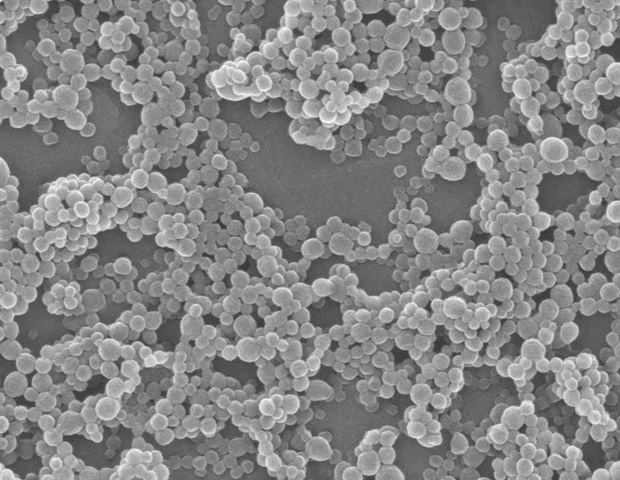Over the past decade, researchers have sought more effective and enduring cancer treatments. Among the wide variety of immunotherapies, Stimulator of Interfron Genes activation (STING agonism) has emerged as a particularly promising approach that harnesses a patient’s immune system to combat tumors throughout the body. Although potentially revolutionary, there remain critical hurdles to overcome before STING agonism can be employed as treatment option for patients. For example, the intravenous administration of STING agonist drugs is often not effective, due to lack of drug stability and poor uptake by immune cells.
Addressing these challenges head-on, investigators at Brigham and Women’s Hospital, a founding member of the Mass General Brigham healthcare system, have now designed stimuli-responsive nanoparticle structures, allowing STING agonist drugs to be released when reaching the target cells. In a paper published today in Nature Nanotechnology, the researchers report that stabilized nanoformulations not only eradicated active tumors in mice but also trained their immune systems to recognize and eliminate future tumors.
Our goal is to use STING agonism to instruct the immune system to treat cancer cells as invaders, which necessitates the design of stable and potent nanostructures that enable STING to reach the right organs and the right cells.”
Natalie Artzi, PhD, Senior Author, Principal Investigator, Brigham’s Department of Medicine
Lead author Pere Dosta Pons, PhD, an instructor in the Brigham’s Department of Medicine, highlighted the novelty of their approach: “We not only are training the immune system to target and eliminate cancer cells, but also to generate immune memory for preventing cancer recurrence.”
STING agonism involves the activation of a protein called the stimulator of interferon genes (STING), which alerts the immune system to the presence of invaders. When the body is infected by a virus or bacterial species, small messenger molecules known as cytosolic cyclic dinucleotides (CDN) attach themselves to STING. This activation prompts the production of proinflammatory cytokines, which in turn activate immune cells such as natural killer cells, macrophages, and T-cells, recruiting them to the affected area to clear the infection.
Cancer evades this STING pathway by disguising itself as the body’s own cells. Researchers have been attempting to teach the immune system to identify and attack cancer cells by delivering STING agonists to immune cells in the tumor microenvironments and tumor-draining lymph nodes.
In their new paper, the Brigham team describes a new nanoparticle structure that more effectively transports CDN molecules into immune cells. This structure directly connects laboratory-produced CDNs to nanoparticles made of poly(beta amino esters), or pBAEs, making the compound more stable and potent when injected into the body, thereby enhancing its therapeutic window. The nanostructure taxis the CDN messengers directly to tumors and detaches the cargo only when reaching the target cells.
To evaluate the effectiveness of their approach, the team administered the CDN-nanoparticle (CDN-NP) compounds to mice with melanoma, colon cancer, and breast cancer tumors. They confirmed that their CDN-nanostructures were taken in by target immune cells in the tumor microenvironment and in secondary-lymphoid organs, providing mice long-term immunity against future tumors. When surviving mice were reintroduced with tumors 60 days after their initial treatment, they were able to reject the tumors on their own.
The team developed a set of design rules that must be considered when delivering immune therapy, including what the role of secondary lymphoid organs is in dictating therapeutic outcomes. They showed that the spleen plays a critical role in coaching the immune system to generate immune memory.
In addition to addressing fundamental questions about cancer and immunology, studies like this one show the potential of improving gene therapy delivery systems for treating diseases such as cancer. Mass General Brigham recently launched its Gene and Cell Therapy Institute to help translate scientific discoveries made by researchers into first-in-human clinical trials and, ultimately, life-changing treatments for patients. The Institute’s multidisciplinary approach sets it apart from others in the space, helping researchers to rapidly advance new therapies and pushing the technological and clinical boundaries of this new frontier.
In explaining the significance of the work, Artzi said, “Our research addresses the fundamental interplay between the immune system and cancer through the use of novel structure that has been designed to be both stable and potent. Moreover, we have demonstrated that targeting secondary lymphoid organs, such as the spleen, is crucial in generating long-lasting antitumor response which has important implications in how we think about immunotherapy delivery.”
Source:
Journal reference:
Dosta, P., et al. (2023). Investigation of the enhanced antitumour potency of STING agonist after conjugation to polymer nanoparticles. Nature Nanotechnology. doi.org/10.1038/s41565-023-01447-7


